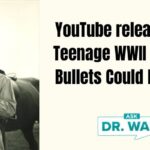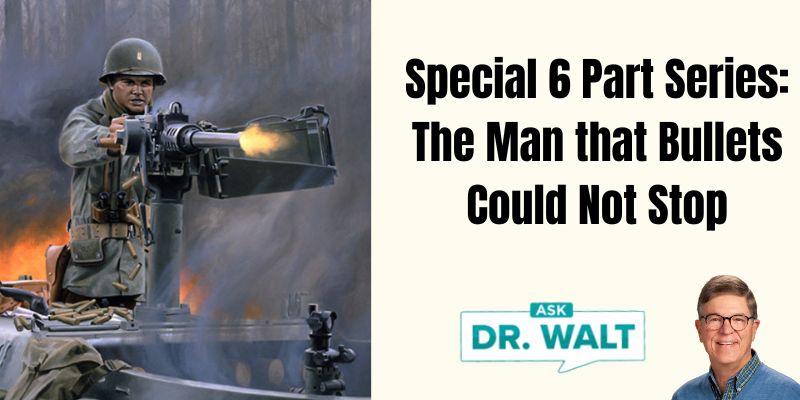
April 9, 1945 (Part 5) — Phil severely wounded one month before the end of the war
April 9, 2025
YouTube releases a video of my presentation: “The Teenage WWII Hero that Bullets Could Not Stop”
April 11, 2025For the last two days (parts 1-5 of this series), I ‘ve been posting what was published in the 2022 version of my and Mike Yorkey’s book, At First Light: A True World War II Story of a Hero, His Bravery, and an Amazing Horse.[1] However, further research has revealed that I did NOT have the story 100% correct. Here’s why:

The book text was based upon two eyewitness accounts that supported Dad’s nomination for his second Silver Star (the Silver Star with an Oak Leaf Cluster) of the war. However, after the book was published, I found a third and much more complete eye witness account from Major Carroll McFalls. This one was used to upgrade his second Silver Star to the Distinguished Service Cross, which is the Army’s second highest valor award after the Medal of Honor. I’ll be inserting [commentary] into the actual statement below;
~~~~~
CERTIFICATE[2]
I, Carroll McFalls, Jr., Major, ASN 0-1294510, Tactical Section, Academic Department, The Infantry School, hereby certify that the following statement Is true to the best of my knowledge and belief:
On 7 April 1945 The 3d Battalion, 30th Infantry captured the town of BAD KISSINGEN, Germany. (at the time., and during the action described herein, I was the S-3 of the 3d Battalion.)
During the night of 7 April, the Battalion received orders from the Regimental Commander, Colonel Lionel C. McGarr, to resume the attack at dawn on the morning of 8 April 1945.
Accordingly, Company K was ordered to take the town of REITERSWIESEN, located about one mile southeast of BAD KISSENGEN(sic), and secure it for a Line of Departure for the coming attack. This was accomplished.
At about 0600, 8 April, Company L, commanded by Captain (then Lieutenant) Phillip(sic) B. Larimore was ordered to prepare his Company for the attack and to report to the Battalion Commander and myself on the LD [line of departure].
Captain Larimore arrived about 0645 and was ordered to attack up the left fork of the road and capture a main road junction. Prisoners had reported an artillery battery emplaced near the RJ [road junction](See Map [however, I’ve not been able to find the maps]) and a considerable number of enemy infantry in the surrounding woods.
At about 0845 Captain Larimore, reinforced by a section of tanks, moved his company out. Almost immediately small enemy outposts and delaying forces opened fire on the point platoon, thereby slowing down the advance of the entire unit.
As it was desired to capture the RJ, and the artillery battery, if possible, Captain Larimore had been ordered to proceed with all possible speed. Aware of the Battalion Commander’s desires, Captain Larimore quickly moved to the head of his company.
Completely disregarding the considerable amount of small arms fire being delivered, Captain Larimore by personal example, moved his leading platoon into the assault. space. Because of his vigorous efforts, the enemy quickly ascertained that he was a commander and redoubled their efforts to destroy him.
Captain Larimore, completely disregarding the fire, so inspired his men that they took the enemy position, killing some enemy and capturing a number of prisoners.
The attack was continued through the woods against scattered resistance from a stubborn foe. Captain Larimore moved at the head of his company throughout the advance, strenuously directing the attack.
At one time during the morning, it was necessary to rout the enemy, estimated to be about two platoons supported by automatic weapons, from a small clearing aside the road (See Map).
Effectively utilizing his tanks and personally directing the fight, Captain Larimore reduced the enemy position. So stubborn was the resistance, it was necessary to engage in some hand-to-hand fighting, of which Captain Larimore was the center.
During the melee, Captain Larimore killed a German officer at point blank range with his pistol. At this point the resistance ceased and about twenty-five enemy were made prisoner.
The attack continued to the objective, the RJ, with such speed that the enemy withdrew, leaving behind two 150-mm howitzers and several rifles, packs, and a considerable amount of ammunition.
Captain Larimore formed a hasty defense line about the RJ and sent patrols out.
At this time, about 1230, the Battalion Commander and myself moved up to the RJ and confirmed with Captain Larimore. He reported that his patrols had discovered Germans in the woods manning two hasty defenses. (See Map)
At approximately 1330 hours. we received an order from Regiment to send a patrol along the left fork of the RJ to attempt to contact the 15th Infantry, who were attacking on our left flank.
The mission was given to [Larimore’s] Company L. The patrol was dispatched and about 1530, Captain Larimore reported by radio that the patrol was surrounded. The patrol had attempted to penetrate the German line.
I went to Company L’s CP [command post] and there found that Captain Larimore had taken a tank and the artillery forward observer [this was NOT his radio man as I reported in the book] and had gone to the assistance of his patrol.
I then proceeded down the left fork of the road, keeping to the ditch, for about 150 yards. There I saw Captain Larimore on the rear of a tank firing at the woods to our front. He was about 200 yards to my front.
Captain Larimore was operating the 50 Cal MG mounted on the tank. Despite tracer bullets which struck the tank within inches of Larimore he coolly continued to fire, changing ammunition boxes regularly and inflicting casualties on the enemy.
I saw Captain Larimore leap or fall from the tank. The enemy fire at the time was very heavy. About this time the tank came back to my position. The tank commander reported he was out of ammunition, and he also reported he had seen Captain Larimore fall near the edge of the woods and thought he had been killed.
I reported to my battalion commander, and he ordered the remaining tank and some reconnaissance 1/4 tons that had just arrived to attack the enemy and get Captain Larimore out. He also took a platoon from Company L to assist in the attack.
The Battalion Commander led the force, and we proceeded under heavy fire to the position where Captain Larimore was lying. It was now approximately 1630 hours. [So, it was NOT the Regimental Commander, Colonel McGarr, and Lieutenant Fitterman that found Dad.]
As we approach the position, the enemy fire ceased and a German officer and about thirty men came out of the woods and surrendered.
Captain Larimore was lying about fifty yards from their position and a dead German killed by himself was lying about ten yards from him. Captain Larimore had been hit in the leg just below the knee, the bullet shattering the bone. He also had two bullet scars on his helmet and his canteen had been penetrated by another bullet. [In the book, I only record the one hit on Dad’s helmet. And, I did not know about the canteen “wound.” If so, I would have inserted this story, that Dad often told, but I had no place in the book to place it.
Dad later told the story of suddenly feeling warm liquid pulsing down his left leg. Although he felt no pain, he thought he had been shot in the hip. He looked down to unbuckle his belt and tourniquet the hemorrhage and said he chuckled when he saw that a bullet had punctured his canteen, and it was just warm water soaking his pants. Just then, he was stunned by a sniper’s bullet that glanced off his helmet.]
Upon questioning the German officer, he stated that had not the tank with Captain Larimore on it appeared at the time, his force could have destroyed the entire patrol. As it was, the patrol pulled out under Captain Larimore’s fire with the loss of only one man killed and a few wounded. The officer further stated that his men were demoralized at the appearance of the man on the tank that bullets could not stop. [Had I known this statement, I think I would have titled the book: “At First Light: A True World War II Story of a Hero that Bullets Could Not Stop.”]
This entire day’s action, which costs the leg of a brilliant young officer, was an inspiration to the entire Battalion.
Captain Larimore displayed qualities of leadership and personal bravery which became a model for the Company Commanders, even every officer and man, in the Regiment.
He, knowing the importance for speed and aggressiveness, personally led his Company in a brilliant, successful attack.
Combining all the arms under his command with personal bravery of the highest order, Captain Larimore led his Company by personal example.
Then, realizing the need for a speedy diversion to extricate a trapped segment of his company, Captain Larimore, himself, deliberately became that diversion, paying no heed to his own personal safety.
Largely through the efforts of this one man The Battalion was able to complete their assigned mission, capturing two 150-mm howitzers and about 150 enemy soldiers, killing about twenty and securing a vital RJ.
Captain Larimore’s action reflects the greatest of credit upon himself and the military service and was an inspiration to all who knew of it.
CARROL McFALLS, JR.
Major, Infantry[2]
~~~~~
The entire series:
- April 8, 1945 (Part 1) — Phil severely wounded one month before the end of the war
- April 8, 1945 (Part 2) — Phil severely wounded one month before the end of the war
- April 8, 1945 (Part 3) — Phil severely wounded one month before the end of the war
- April 9, 1945 (Part 4) — Phil severely wounded one month before the end of the war
- April 9, 1945 (Part 5) — Phil severely wounded one month before the end of the war
- April 10, 1945 (Part 6) — Phil Larimore the man that bullets could not stop
~~~~~

~~~~~
[1] Larimore, At First Light, 253-267.
[2] Eyewitness statement used in considering Phil’s DSC award. Typed at the bottom, “May 5, 1947. Considered by the War and Military Decorations Board.”
Learn more about my book about my father’s heroics and exploits at Amazon’s First Light page here. You can also read more of my WWII blogs here as well!
© Copyright WLL, INC. 2025.




2 Comments
The courage and shear determination it took for Capt Larimore to successfully execute these actions and survive is unimaginable. Thankful for all who serve today and in the past.
Paul,
Amen to that. As my father shared his was stories, I began researching the forgotten southern front in Europe. I asked him once what it felt like to be a hero. He replied, “Two million men fought in Europe. I was one of over 500,000 American casualties, but there are over 100,000 buried there. Those are the real heroes. Not me!” I think that almost all of them were.
Walt